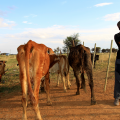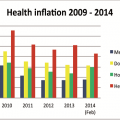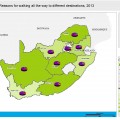
Agricultural households at municipality level: The case of Buffalo City vs. Mangaung
The 2011 population census included a set of questions designed to gather information about households that are involved in some form of agricultural activity. These results were made available on a provincial basis on 31 March 2014. Stats SA can now disseminate the information on a municipal level as well. To illustrate its use, the read more »

Inflation just under the South African Reserve Bank (SARB) target ceiling
Consumer inflation edged up to 5,9% in February, just under the SARB target ceiling of 6%, from the 5,8% recorded in January. The monthly increase was 1,1%. There were three main groups contributing to the upward pressure this month – food, petrol and health insurance. Food and non-alcoholic beverages inflation increased to 5,4%, from 3,5% read more »
Formal sector employment increases in quarter 4
The Quarterly Employment Survey (QES) results show that number of employees working in businesses increased by 38 thousand – from 8 457 000 in the third quarter of 2013 to 8 495 000 in the fourth quarter. This was driven by an increase of 35 000 in the Trade industry and increases in the Community and social services read more »

A tale of two cities: Mortality and Causes of death in Cape Town and Tshwane
In 2011, 26 466 deaths that took place in Cape Town were recorded, compared to 19 574 deaths that occurred in Tshwane. Both cities had a decrease in the number of deaths from those observed in 2010, with a higher decrease observed for Cape Town (5,6%) than for Tshwane (1,7%). Most deaths that occurred in Cape Town read more »
Mbalo Brief – March 2014
This month women across the globe celebrated International Women’s Day (IWD) – a day conceived at the 1910 International Women’s Conference in Denmark. Originally proposed at the 1910 conference by German socialist, Luise Zietz, with the support of fellow German political leader Clara Zetkin, the day was intended to celebrate achievements relating to women’s rights read more »
Media Invite, Mortality and Causes of Death in South Africa
Mortality and Causes of Death in South Africa The Statistician-General, Pali Lehohla, will release a report on the Mortality and Causes of Death in South Africa on Tuesday 18 March. The report presents statistics on the number and causes of death for 2011 and also provides information on trends in mortality and causes of deaths read more »
The National Household Travel Survey in South Africa (NHTS)
Media Release 12 March 2014 The National Household Travel Survey in South Africa (NHTS) The National Household Travel Survey (NHTS) reveals that barriers to mobility in the country have been reduced in the last ten years, yet several challenges remain. Rural households had better access to public transport and had reduced travel times. There has read more »

South Africans willingly put on their walking shoes
It would appear that South Africans are quite happy to wear out their shoe leather by walking to nearby destinations. Across all provinces, the majority of respondents indicated that they used their own energy to get to where they were going if their destination was nearby. Northern Cape had the lowest percentage of travellers who read more »
Re: Break of Embargo Rule by Dow Jones Journalist
Media Announcement 26 February 2014 Re: Break of Embargo Rule by Dow Jones Journalist Wall Street Journal- Dow Jones journalist recently attended the embargoed release of the GDP results of the last quarter of 2013 at Statistics South Africa (Stats SA) offices and violated the rules of the embargo by releasing the data 22 minutes read more »
Export and import unit value indices, 25 February 2014
Highlights Stats SA will introduce a new Export and import unit value index (UVI) to replace the current Export and import price indices. The UVI series will be based on customs data from SARS and includes a much wider span of international trade transactions than is possible with the historic price index. The new index read more »

